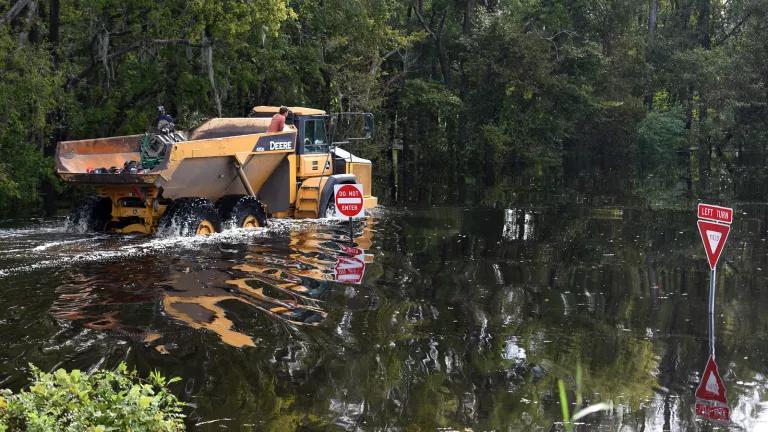States Need to Go Back to the Well and Leverage SRF Dollars
Over the next few decades, the United States is facing a $1 trillion shortfall in water infrastructure funding. To close this gap, more federal funding is needed. States could be doing much more to leverage federal funding they already have received through their Clean Water and Drinking Water State Revolving Funds (SRFs). "Go Back to the Well", a report released by NRDC, finds that states are missing the opportunity to generate new funding through their existing SRF programs.

Water infrastructure is particularly vulnerable to flooding and sea level rise. This plant near St. Louis, Missouri has flooded more than once in recent years. Fixing plants like these will be costly as climate change makes these damages more likely.
Over the next few decades, the United States is facing a $1 trillion shortfall in water infrastructure funding. To close this gap, more federal funding is needed. States could be doing much more to leverage federal funding they already have received through their Clean Water and Drinking Water State Revolving Funds (SRFs).
Go Back to the Well, a report released by NRDC, finds that states are missing the opportunity to generate new funding through their existing SRF programs, through the use of more innovative financing practices. As a result, states are failing to provide all the funding that’s possible to ensure safe, reliable, and resilient water infrastructure.
EPA estimates that $745 billion is needed just to meet and maintain existing public health and environmental standards (the $745 billion includes estimates for clean water and drinking water). Another $448 to $944 billion will be required to adapt water systems to deal with flooding, sea level rise, droughts, and other impacts of climate change. NRDC has identified four actions federal and state governments can take to help close the nation’s trillion dollar funding gap for water infrastructure.
- Congress should triple appropriations for the Clean Water and Drinking Water State Revolving Funds (SRF) from the current level of $2 billion to $6 billion annually.
- States should make loan guarantees available to more easily and cheaply finance drinking water, wastewater and stormwater projects.
- States should leverage additional funding for their SRF programs by issuing bonds.
- Congress should allow states that increase the funding of their SRFs to provide additional subsidized assistance in order to meet the needs of low-income communities and catalyze investments in projects that are currently underrepresented in SRF portfolios.
States Are Not Generating Adequate Funding for Water Infrastructure
Congress established the Clean Water State Revolving Fund (CWSRF) and Drinking Water State Revolving Fund (DWSRF) to provide states sustainable, long-term financial assistance to support communities’ water infrastructure needs. These funds have provided $151.2 billion in financial assistance since their inception, but their full potential remains untapped by most states.
Go Back to the Well recommends ways that states could more effectively leverage water infrastructure funding through their SRFs using loan guarantees and the sale of bonds.
States have utterly failed to use their ability to issue loan guarantees backed by their SRFs. A loan guarantee serves the same purpose as someone cosigning a loan for an individual—providing a promise to repay the loan if the recipient defaults. SRFs can essentially cosign a community’s loan or bond sale, guaranteeing the debt and eliminating the risk of default for private bondholders. By issuing loan guarantees, SRFs allow communities to secure private financing at a significantly lower cost. The use of loan guarantees has been recognized by the EPA as a best practice. But to date, only one SRF-backed loan guarantee has been issued in the history of both SRF programs – a single loan guarantee for $24.3 million in New York State (a miniscule 0.15 percent of the $15.5 billion in CWSRF assistance that New York has provided).
States also have the ability to sell bonds and grow the amount of financial assistance they make available to communities, but twenty-two states have done no bonding and most states are doing relatively little. Only a handful of states are making a habit of this strategy for growing their SRFs financial capacity.
For the CWSRF, we found that twenty-eight states have leveraged $43 billion through bond sales since 1987. But 75 percent of all bond revenues come from just nine states: New York, Massachusetts, Michigan, Ohio, Texas, Indiana, New Jersey, Connecticut, and Missouri. Through 2015, most other states were sporadically pursuing relatively small amounts of additional financing through bond sales.

The same is true for the DWSRF. Twenty-two states have leveraged $8 billion through bond sales since 1998, with 75 percent of all bond revenues coming from a small number of states: New York, Massachusetts, Ohio, Oklahoma, Michigan, New Jersey, Indiana, Kansas, and Iowa. Twenty-eight states have done no bonding and among those that are, most are sporadically pursuing relatively small amounts of funding.

Essentially, the majority of states are managing their SRF programs the way your or I might manage your checking account. Each year, they add up how much EPA gives them plus a small state match, and that’s the amount of assistance they provide communities to fix their drinking water and sewer systems. That approach is not going to cut it and leaves much-needed funding on the sidelines.
Communities desperately need funding in order to maintain and improve their water infrastructure, especially when the impacts of climate change are factored into the equation. Drinking water, wastewater, and stormwater systems will need to be re-engineered and, in some cases, relocated to cope with the impacts of floods, droughts, and sea level rise.
Because wastewater and drinking water systems are often built near rivers and coastlines, they are vulnerable to floods and sea level rise. Hurricane Sandy inflicted more than $5 billion in damages on wastewater infrastructure when it struck New York, New Jersey, and Connecticut in 2012. Hundreds of millions more were spent to make the damaged systems more resilient, and better able to cope with similar storms in the future. Pensacola, Florida spent $300 million to replace and relocate an outdated wastewater treatment plant. The old plant was built on the coastline, where it was vulnerable to storm damage. They put the new plant farther inland where floods and sea level rise are less of a concern.
But there are many more vulnerable systems. A recent study from the University of California-Berkeley found that 162 sewage plants serving 10.4 million Americans could be inundated by three feet of sea level rise. With six feet of sea level rise, that climbs to 394 plans serving 31.6 million people. The costs of protecting or relocating all these plants will be enormous.
Go Back to the Well shows the current state of play for state water infrastructure financing through their SRF programs, and also makes recommendations for federal policy changes that could incentivize states to make use of tools like leveraged bonding and loan guarantees to grow their SRF programs’ financial capacity.
Using more creative financial tools, like issuing bonds and using their SRFs to issue loan guarantees, states could greatly expand infrastructure funding. Those increased funds could determine which states and communities are prepared to weather the coming storms.




